introduction
If you're new to sea slugs, sea slug
is a non-scientific term that usually refers to nudibranchs.
That's pronounced with a hard ch
, like nudibranck
.
Nudibranchs are a taxonomic order (Nudibranchia) representing about 3 000 species of incredible
diversity.
So Cratena peregrina has many, many cousins.
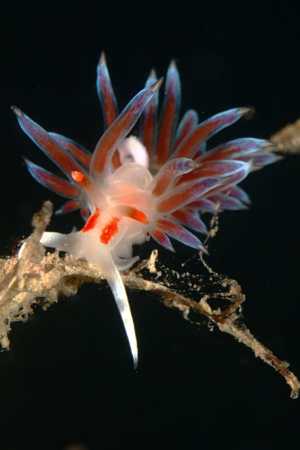
By my on non-scientific observation, C. peregrina is the second-most common nudibranch in our local Maltese waters. The most common, again by observation, is the Flabellina affinis.
If you're diving in the Mediterranean or the eastern Atlantic, you can spot this creature by looking for its signature splash of white, blue, and bit of orange. They're usually around three or four centrimetres in length.
The most common place to sight these creatures is on outcroppings: the corners of wrecks, anchors or other detritus, etc.
If you come across a C. peregrina, take some time to observe! Don't get too close—they're small enough that it takes just a fin-sweep to dislodge them. But do take the time to get some photos or, if not in the photography mood, just enjoy the view.
Here are the most recent C. peregrina photos from Not Awful UW Photos. They're licensed CC BY-SA 4.0 (i.e., free with attribution). Please attribute me, Kristaps, with a link to this page or domain. For the full gallery, see the C. peregrina tag set.
appearance
How do you spot a C. peregrina? First, in their usual habitat, they'll show up pretty obviously because of their colours. As you're swimming along, look for bright white spots no more than five centimetres in length and maybe a centimetre wide. If you have good vision, the bright white will be fringed with blue and orange. Sometimes the blue is more violet and sometimes the orange more or less red, but the white usually stands out the most.
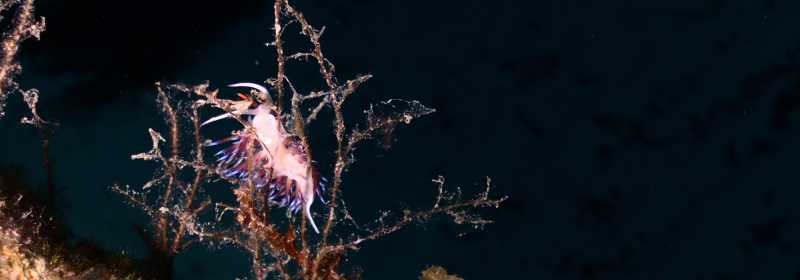
As you can see, this species is pretty easy to see, even in poor light conditions.
C. peregrina orients head-first, with the head being the end with two orange
horns
, two white tusks
, and two orange eye patches in between.
The orange horns are called rhinophores, and act as their nose—nudibranchs in general have
poor eyesight, and instead use their rhinophores to smell
their food.
Their rhinophores are smooth, begin in white, changing to orange with white tips.
The tusks are called oral tentacles, and are used to shovel food into their mouths.
The tentacles are white, smooth, and usually a fair bit longer than the rhinophores.
The mouth opening sits between and slightly below these tenacles.
The orange patch between marks where the eyes are, but I'm yet to read that the colour has anything to do with its vision.
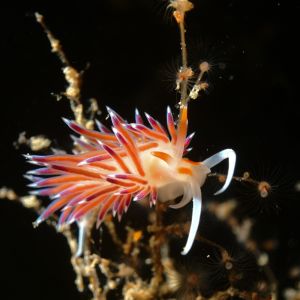
From the head onward, the body itself is in clear white, though sometimes tinged orange depending on the subject's diet and (of course) reflected light from the other parts of the body.
The body has rows of smooth orange-blue-white tufts extending from it.
These are called cerata in the plural, or a single ceras.
Like the word nudibranch, cerata and ceras derive from Greek, so they're pronounced
like kerata
, though you'll often hear it like serata
.
Regardless pronounciation, the cerata are arranged in seven rows, with the first row usually split in
the middle.
The body ends in a short tail
extending out without any cerata.
The up
side is the one with the cerata.
The cerata perform two tasks for the C. peregrina (and indeed most nudibranchs): they act as gills for oxygen exchange and also extend the digestive tract. So the colour of your subject's food—I'll talk about this in the habitat section—influences the colour of the cerata.
You can't usually see them, but C. peregrina has reproductive and digestive organs sandwiched between the first and second row of cerata. None of my photos actually show these (yet).
habitat & feeding
The habitat of C. peregrina is tied to its food source. In effect, this species eats its home. The food source in question are Eudendrium hydroids found in our shallow Mediterranean waters. Eudendrium is a taxonomic order of 78 different species. In Malta, they prey primarily on the Eudendrium racemosum species. These look a bit like spindly underwater branches.
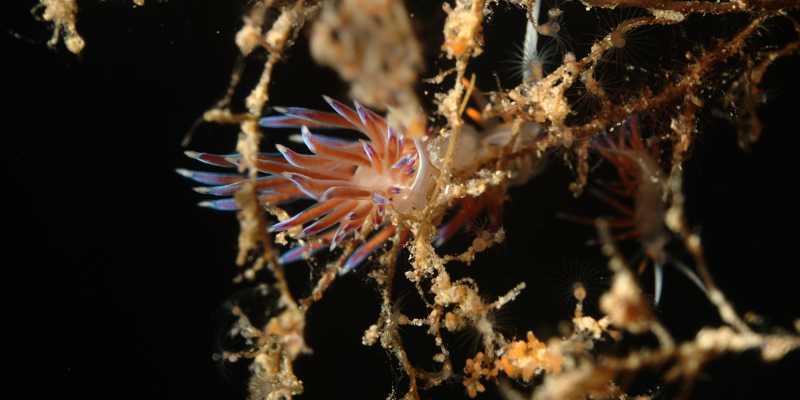
Since these hydroids tend to live in well-oxygenated, shallow waters, this is where we also find the C. peregrina.
In recent years, C. peregrina has been the subject of study in kleptopredation
.
This is eating food not for just its own nutrients, but for the nutrients of what the food itself
consumes!
In short, it was found that C. peregrina prefer consuming hydroids that have recently fed
themselves (hydroids are predators too).
photography
Are you setting out to photograph the C. peregrina? First, make sure your buddies know: you're going to be in the same place for a long time, as your subjects are quite difficult to photograph. Not only are they quite small—less than five centimetres in length, usually around three—but the intense white colour of their bodies generally overexposes in strobes.
In general, photographing C. peregrina follows the same rules as any macro photography: a smaller aperture (since the macro will otherwise make a tiny focus depth) and as fast a shutter as your lighting will allow. Usually, macro shots are shot with strobes and high shutter speeds to darken ambient light (the background) as much as possible.
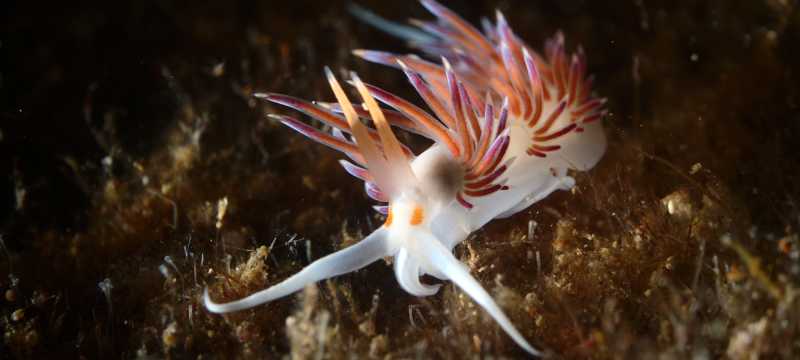
The hard part is getting focus at all—remember that you're probably moving with the current, and any movement will affect your focus! Be prepared to shoot many, many, many attempts. Do not ever touch or influence the nudibranch to move.
The harder part, although it need only be dialled in once, is lighting: too much lighting and the body will overexpose. Too little and you'll need to either enlarge the aparture (making focus even more difficult!) or reduce shutter speed. Consider having the preview mode of your camera be set to show over and under exposure.
In the above example, the oral tentacles are still a bit overexposed. And the focus seems to be around the first row of cerata—not the head. Close enough!
When is the best time to take photographs? What follows is a thoroughly un-scientific chart of C. peregrina specimens photographed over time. It's hugely influenced by whether I dived at all; and if so, where. This should follow a pattern due to their reproduction, but I don't have enough data to create any sort of connections.

references
I recommend the sea slug forum on C. peregrina for casual (but well-researched) questions.
For a good overall description of the species, I suggest
Padula, Vinicius & Araujo, Ana & Matthews-Cascon, Helena & Schroedl, Michael.
Is the Mediterranean nudibranch Cratena peregrina (Gmelin, 1791) present on the Brazilian coast?
Integrative species delimitation and description of Cratena minor n. sp.
Journal of Molluscan Studies (2014). 80. 10.1093/mollus/eyu052.
Lastly, the concept of kleptopredation is discussed at length in
Trevor J. Willis & Kimberly T. L. Berglöf & Rona A. R. McGill & Luigi Musco & Stefano
Piraino & Claire M. Rumsey & Tomás Vega Fernández & Fabio Badalamenti.
Kleptopredation:
a mechanism to facilitate planktivory in a benthic mollusc.
Royal Society: Biology Letters (2017). Volume 13, issue 11.
